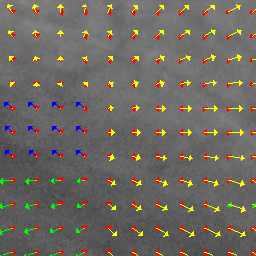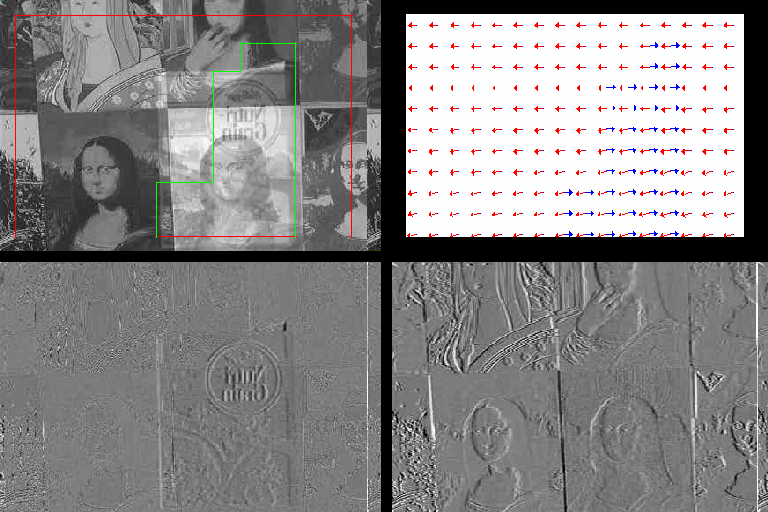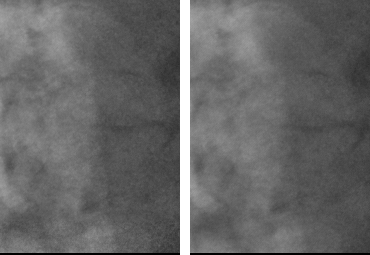Vincent Auvray - Contributions
(Back)
Quick insight of the transparent motion estimation
Three main approaches are proposed in the litterature to estimate transparent motions:
Partial adaptation of classical motion estimators (Black and Anandan, Irani and Peleg), but for partial transparencies only.
Detection of planes in the 3D Fourier space (Shizawa and Mase, Pingault and Pellerin, Stuke and Aach),
but it must assume that motions are translationals over dozen of frames.
Transparent motion estimation in the direct space (Pingault and Pellerin, Stuke and Aach, Toro), which relies on an
equation equivalent for the brightness consistancy. For two layers:
It assumes that the motions are constant over two successive time intervals.
Our contributions belong to this last class of approches. (More)
Our contributions in bitransparent configuration
In a first time, we have developed a synthetic image generation process which follows the physics of X-Ray
image formation. That allows us to compare our estimates to a known ground truth.
(More)
Our first mature algorithms (presented to ICIP'05) allows to reach precisions of 0.6 pixels
over diagnostic images and 1.4 on fluoroscopic images. But at that point we had not simulated the MTF nor the scatter yet, and the
accuracy turned out to be much lower on these more realistic images.
This is why we imagined a second algorithm, presented at MICCAI'05. To be as robust to noise
as possible, we tried to constraint the problem as much as we could. Many real exams observations convinced us that the anatomical
motions (heart beating, lungs dilation, diaphragm translation) could be modeled with affine displacement fields.
Estimating these transparent motion fields boils down to minimizing an energy. We perform this task practically in an
Gauss-Newton incremental multiresolution framework (initialized with the simplex method).
This approach allows for precisions of 0.36 and 0.7 pixels on images without MTF nor scatter, but more importantly of 0.75 and 2.85
pixels on images typical for diagnostic and interventional images respectively.
We finally proposed in ICIP'06 an evolution of this algorithm, reaching precisions of 0.6
pixels on diagnostic images and 1.2 on fluoroscopic images, and presented real examples.
 Estimated motion fields on a part of cardiac exam in situation of bi-transparency.
Estimated motion fields on a part of cardiac exam in situation of bi-transparency.
The example above shows a portion of a cardiac exam in a situation of bi-transparency. It corresponds to a about 5cm x 5cm area
between heart and lungs. The dark region on the bottom left part corresponds to the heart, and the bright region on the top right
to the lungs. We face a situation of bi-transparency since heart and lungs move coherently over a static background (spine and ribs).
(Back)(Demos)
Our contributions in bidistributed transparency
Our contributions until that point estimated the transparent motions present in a sequence showing one configuration only:
two layers having coherent motions were present over the whole image. Most of the contributions on this topic refer to this
situation.
Now, the real images are more complex: they contain more than two layers overall, but rarely more than two locally. Which is why
we have introduced the concept of bidistributed transparency to account for images that can be segmented in areas
containing one or two layers.
We present in ICIP'06 a joint transparent motion estimation and segmentation
method that allows for precions of 0.6 pixels on diagnostic images and 1.2 on fluoroscopic images.(More)
 Two images for a fluoroscopic sequence, the estimated motions (the field corresponding to the background is worth
zero and thus invisible) and the resulting segmentation.
Two images for a fluoroscopic sequence, the estimated motions (the field corresponding to the background is worth
zero and thus invisible) and the resulting segmentation.
 Processing of a video sequence in a situation of bi-distributed transparency. Top left: the segmentation in layers,
top right the estimated motions, and on the bottom the compensated difference images.
Processing of a video sequence in a situation of bi-distributed transparency. Top left: the segmentation in layers,
top right the estimated motions, and on the bottom the compensated difference images.
We also present a demo, showing the different stages of motion estimation.
Application to denoising
We also need to know how to use this motion information to denoise our sequences. We have proposed an original framework to do so
in MICCAI'05.
. It yielded a very disappointing asymptotic deoising of 20%.
(More)
We have therefore developed the so-called hybrid filters, which decide locally between different possible motion compensations:
Transparent motion compensation when both layers are textured.
Compensation of the motion of the more textured layer in any other case (one layer only is textured, or both layers are homogeneous). This way,
we preserve the useful information without impairing the achievable denoising power.
This approach can be used both in purely temporal denoising filter, as well as in spatio-temporal denoising filters. In the former case, we achieve
a denoising of about 50% (in standart deviation), without useful information blurring (submitted to ISBI'07).
 Fluoroscopic sequence processing with the temporal hybrid filter (left) and a classical adaptative temporal filter (right).
The heart is much more contrasted on the left for an equivalent denoising.
Fluoroscopic sequence processing with the temporal hybrid filter (left) and a classical adaptative temporal filter (right).
The heart is much more contrasted on the left for an equivalent denoising.
Back



